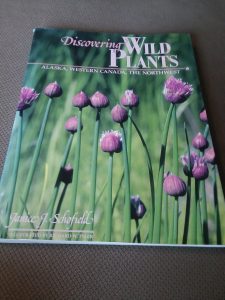The good, the bad, and the weedy
How can I fertilize my soil naturally without using animal waste? What native plants will grow together and compliment each other? How can I attract bees? That looks like a weed – can I eat it? In Discovering Wild Plants by Janice Schofield, I found not only the answers to these questions, but so much more. Open the book’s pages (there are no online resources associated with this book) and find instructions on how to make herbal remedies and recipes that make your stomach growl with delight. Learn from European and traditional knowledge of native plants, and black-and-white drawings of each plant that are just as beautiful as they are informative. Want to know if you’re picking harmless wild geraniums for your granny or the deadly monkshood? You should probably flip to pages 159 and 169 to read the ‘caution’ section for each plant! Schofield’s book is one I have been referencing for years, but still find something new in each time I open its pages.
Oh the places you’ll grow!
Organized by the habitat in which each plant occurs (‘Marshes, Ponds, and Wet Places’ and ‘Forests and Open Woods’ are just 2 of 7 categories listed), Schofield walks you through the harvest schedules, historical, food, and medicinal uses, and physical descriptions of more than 130 plants native to Alaska, Western Canada and the Northwest.

Flip through the ‘Gardens, Lawns, Cultivated and Disturbed Soils’ section and you’ll learn that clover, always associated with an annoying lawn weed, is actually an excellent nitrogen fixer, and that chickweed, dandelion greens, and wild mustard combine to create a delicious addition to any salad. In the impressive section on seaweeds, arrow grass and other beachy botanicals, I discovered that according to the UAF Cooperative Extension, seaweeds do not increase soil acidity and ashes from burned seaweed provide the perfect nutrient fix for potatoes. With such diverse categories (including helpful subcategories found under the contents in the first few pages for maximum organizing), the reader isn’t required to even know the exact name of the species in question. Simply knowing where the plant grows and what the plant looks like will get you started.
Aided by the drawings and physical descriptions by artist and long time Homer resident, Richard Tyler, detailed color photos, and Schofield’s anecdotal examples that highlight her enthusiasm for the natural world, even the dullest mushroom or slimiest seaweed takes on new life.
The dirt is in the details
This book features information from universities, renowned herbalists, and people in villages from Alaska to Canada who have been passing down their knowledge for generations. For example, in the pages describing the traits and uses of the crowberry (Empetrum nigrum), Schofield relays the uses of crowberries by the Dena’ina Athabascans and the people of the Kobuk River region as cure for diarrhea and decoction for snowblindness. Under the food uses, Schofield mentions Ed Berg of Homer’s recommendations for using crowberries as an extender for pies and other berry dishes due to their unexciting flavor when eaten uncooked. There is even a recipe for berry liqueur, for yet another use option of this versatile fruit. When you realize this is just a small sampling of the uses for one particular berry out of over 130 plants in this book, you almost feel overwhelmed by the sheer amount of information at your finger tips. No internet required!
Originally published in 1989, some of the materials referenced in Discovering Wild Plants are notably outdated. A glance at the bibliography will show a range of materials dating from 1914 to 1986. Despite a number of aging scientific references, I believe this book is still quite relevant for what it was originally intended for – to give experienced botanists and beginning enthusiasts alike a useful, detailed, and easy to understand guide for everything botanical. All of Schofield’s sources can be found in her detailed bibliography at the end of her book, along with a herb directory, glossary, index, and additional information on harvesting and drying herbs, homeopathy, and treatment of acute poisoning.
Whether you are a plant aficionado, or trying to sprout a green thumb, Discovering Wild Plants has something for you. Don’t be intimidated by the amount of information presented. Just think of it as a plant library, where you can check out information as you need it. I have used this book for everything from a cookbook, an organic gardening ‘how to’, and a plant field guide while on hikes around the local area, and have never been disappointed, though my one complaint overall is the size of the book makes quick referencing and packing this volume with you a little bit of a challenge. Aside from its textbook-worthy heft, there is nothing more detailed. With its beautiful color photos, detailed illustrations, and copious recipes and recommendations, I couldn’t suggest a better guide to Alaska’s flora.